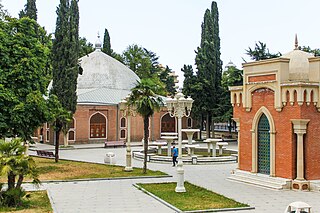
Ganja is Azerbaijan's third largest city, with a population of around 335,600. The city has been a historic and cultural center throughout most of its existence. It was the capital of the Ganja Khanate until 1804; after Qajar Iran ceded it to the Russian Empire following the Treaty of Gulistan in 1813, it became part of the administrative divisions of the Georgia Governorate, Georgia-Imeretia Governorate, Tiflis Governorate, and Elizavetpol Governorate. Following the dissolution of the Russian Empire and the Transcaucasian Democratic Federative Republic, it became a part of the Azerbaijan Democratic Republic, followed by Azerbaijan SSR, and, since 1991, the Republic of Azerbaijan.

Ganja State University is a public university in Ganja, Azerbaijan. Officially accredited and recognized by the Ministry of Science and Education of Azerbaijan), Ganja State University is a medium-sized coeducational higher education institution. The university offers courses and programs leading to officially recognized higher education degrees such as bachelor degrees, master degrees, and doctorate degrees in several areas of study. The 80 years old higher-education institution has a selective admission policy based on entrance examinations. The admission rate range is 80-90% making this Azerbaijani higher education organization a least selective institution. There are 20 doctors and professors, 156 doctoral candidates and associate professors, and 150 assistant professors and lecturers in the 26 departments of the university. The university has a library, several computer rooms and laboratories. The university ranks as 19th best nationwide and 8547th best worldwide.

Azerbaijan State Agricultural University, also referred to as the Azerbaijan State Agricultural University, is a public university located in Ganja, Azerbaijan. The university has eight schools, 6000 students and 560 faculty members. In addition, there is a teaching site in Gazakh with nearly 500 correspondent students.

Kapaz PFK, is an Azerbaijani football club based in Ganja, which competes in the Azerbaijan Premier League, the highest tier of Azerbaijan football. The club was founded as Toxucu in 1959. They have won the Azerbaijani Championship 3 times and the Azerbaijani Football Cup 4 times.
The 1920 Ganja revolt was a popular uprising against the Soviet occupation that took place in Ganja on 26 to 31 May 1920. The goal of the uprising was to liberate Azerbaijan from the Soviet army and put an end to the arbitrariness of the communists. This was the largest rebellion against Soviet rule in Azerbaijan in the 20th century, and caused the most losses. The organisers and leading force of the uprising were officers of the army of the former Azerbaijan Democratic Republic.

The Ancient Gates of Ganja were a masterpiece of craftsmanship of the 10th to 11th centuries.

Imamzadeh Mausoleum or Goy Imam Mosque is located 7 km northward to Ganja. It consists of a complex including walls with entrances, small mosques and funerary monuments. The mausoleum, located inside the mosque, bears the grave of Imamzadeh Ibrahim, son of Imam Muhammad al-Baqir, the fifth Imam of Shi'a Muslims.
Hajikend is a town in the administrative-territorial unit of Kapaz raion of Ganja, Azerbaijan. It has an area of 107 hectares and population of 489.

Ganja State History-Ethnography Museum named after Nizami Ganjavi is the largest museum in Ganja,

Ganja State Puppet Theatre is located on Ahmad Jamil Street 105 in Ganja, Azerbaijan.

Ganja Fortress is a fortress in Ganja, Azerbaijan. The remains of walls of the fortress can be seen in the territory of the oldest park of the city, Khan's Garden and in the entrance to the city, along the Ganja River.

Ganja is the second largest city of Azerbaijan, according to its population (331.4 thousand, however, it is behind Baku and Sumqayit in terms of industrial production. The city is located in Ganja-Gazakh economic region. The economy of Ganja embraces the issues connected to the economy of the city of Ganja. Industry, tourism, agriculture, and transportation are the major branches of its economy. Most of the total volume of industrial products is accounted for non-ferrous metallurgy, light and food industries, electronics industry and home appliances.

The Heydar Aliyev Park Complex is the largest urban park in Ganja, Azerbaijan located on an area of 450 hectares. It includes within its boundaries fountains and decorated garden plots, an amphitheater, “Triumphal arch”, Youth Center, Heydar Aliyev Center, Museum of Modern Art, a waterfall and an artificial lake in addition to thousands of trees. The Park Complex was opened in 2014.

House-Museum of Bulbul is the Shusha branch of the Bulbul memorial museum in Baku, Azerbaijan, until 1992. It was previously in a ruined status but, has been recently restored.

The Ganja ballistic missile attacks comprise four separate ballistic missile attacks on the city of Ganja, Azerbaijan, in October 2020, carried out by the Armenian military forces during the Second Nagorno-Karabakh War.

Ganja-Dashkasan Economic Region is one of the 14 economic regions of Azerbaijan. It borders Georgia to the north and Armenia to the south, as well as the economic regions of Shaki-Zagatala, Central Aran, Karabakh, East Zangezur, and Gazakh-Tovuz. The region consists of the districts of Dashkasan, Goranboy, Goygol, Samukh, as well as the cities of Ganja and Naftalan. It has an area of 5,270 square kilometres (2,030 sq mi). Its population was estimated to be at 611.3 thousand people in January 2021.

Shah Abbas Square is a square located in the historical center of the city of Ganja, Azerbaijan. At one time, it was the main memorial complex of the suburb of the Ganja fortress. The complex of Shah Abbas Square was firstly mentioned in the plan of the Ganja fortress of 1797. This architectural ensemble, located in the center of the suburb, consisted of a mosque, a bathhouse and other buildings.

Javad bey Mammad agha oghlu Shikhlinski was an officer of the Tsarist army, a major general of the Azerbaijan Republic Army, and the commander of the Ardabil garrison in the Qajar army.

Ismail Khan Ziyadkhanov or Ismail Khan Ziyadkhanly was a member of the government of the Azerbaijan Democratic Republic, a diplomat, and a lieutenant colonel in the army of the Azerbaijan Democratic Republic. He was one of the five Azerbaijanis elected to the First State Duma of the Russian Empire.


















